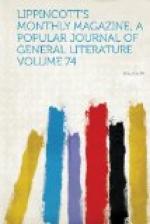While he spoke my imagination was already turning over the leaves of a history of that stately monument, around which clusters so much of Middle-Age story, and looking at copies of forms and faces which to remember is a dream of rainbows and angels. There should be that quaint Madonna who points her thumb over her shoulder at St. Francis while she asks her Son to bless him, and the three saints and the Madonna of the north transept, and the pictures at the entrance of the chapel of San Martino, and the vault of the chapel of St. Louis, and a thousand other lovely things.
And, “Signor Professore,” I said eagerly, “how I should like to translate that work, pictures and all, into English!”
He cordially consented, with many compliments.
As we left the loggia he pointed to the arch opposite the entrance-door. “That is the arch of suicides,” he said: “more than one man has thrown himself down that precipice.”
We were joined by a Benedictine monk as we went but, who proposed that we should go up the campanile. It is pleasant to visit the bells of a famous or favorite church. It is like seeing a poet whose songs we have heard, and pleasanter in some respects; for while the poet may mantle himself in commonplace at our approach, like Olympus in clouds, one can always waken the spirit of song in these airy singers.
The way up this campanile is very rough, a mere gravelly path, and one can only maintain his footing by holding a rope that runs all the way up, following the four sides. Reaching the large chamber at the top, we paid our respects to the seven bells, whose intricate changes I had so many times tried to follow. Their ringing is a puzzle. In the middle hung the melancholy campanone, with a silvery soprano by its side—a very Dante and Beatrice among bells.
We stayed to hear the noon Angelus strike, and while the last stroke was still booming around the great bell I took a step toward it and stretched my hand out.
I was instantly snatched backward, with a profusion of excuses.
“It is said,” the professor explained, “that if a bell be touched, even with the finger-tip, while ringing, it will instantly break. I do not know if it be true, but it is worth guarding against.”
It was indeed! A fine appetite I should have had for my breakfast, at that moment awaiting me, if I had had to reflect over it that the great bell of the great basilica of St. Francis of Asisi had that very morning been cracked into pieces by my fore finger! What visions of horrified crowds of Asisinati, of black storms of newspaper items, of censuring gossip the world over, would have come between me and that purple pigeon smothered in rice which Maria had promised me! The pope himself would have known me individually out of the cloud of his subjects, and have frowned upon my image. And how it would have been whispered behind me to the end of my days, “That is the lady who broke the great bell of St. Francis”! But I had not broken it, and it still hangs sound and strong, to send its melancholy sweet music out to meet the centuries as they roll in storm and sunshine over the eastern mountains. Let us be thankful for the evils which might have happened and did not.




